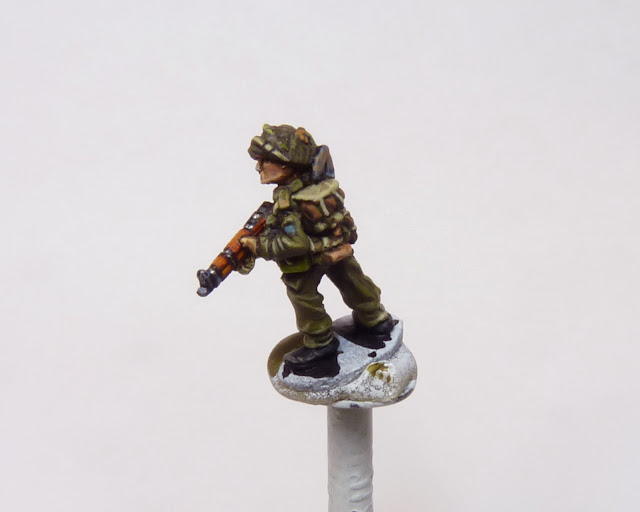Felt a bit of patriotism on Canada Day so decided to do a test run of some Canadian Troopers (and take a break from Germans and Russians!) I wanted to solidify color choices so mostly worked on one figure. I bought the BBX11 British Rifle Company a few years back with the plan that at some point I would do up a D-Day Canadian force fighting in Normandy.
The sculps are a bit blocky typical of BF style and are pretty good overall with the only major bitch (am I ever happy?) is the Mk.III ‘turtle’ helmet modelled. On many of the figures, it is more flat on the sides than it should be. I played around a bit with one figure, scraping off the netting and adding one made of nylon stocking (stole from the wife - not mine...really!)
All my color choices for these figures will be updated in the "Recommended Colors" link on the left side of the blog.
I plan on painting them up to represent the 3rd Canadian Division, specifically the Royal Winnipeg Rifles of the 7th Infantry Brigade. The divisional patch is a blue/grey square with the Regimental patch above it. in a black arc with white lettering.
The advancing bren gunner pose (center minis - below) is a bit dwarfish. I removed the legs on a couple otherwise great looking minis and added some bulk with epoxy. I then attached some longer legs from two spare riflemen. The different legs and a new head make it difficult realize that theses are the same mini. You can really make your figures unique with simple conversions.
These sculpts are unique in that they are the only ones modelled with the bi-pod folded back - not forward - which BF chooses to do with most of the Brens to strengthen the barrel (see figure below-left).
Personally I wish BF would model the Bren bi-pod back as this is the most common method seen in pictorial evidence. Ill be careful with the barrel ok?
 As well, I added a new head sculpt and a carrying handle on one figure that is missing on all of the Brens.
As well, I added a new head sculpt and a carrying handle on one figure that is missing on all of the Brens.
Stay tuned...
Troy
These sculpts are unique in that they are the only ones modelled with the bi-pod folded back - not forward - which BF chooses to do with most of the Brens to strengthen the barrel (see figure below-left).
Personally I wish BF would model the Bren bi-pod back as this is the most common method seen in pictorial evidence. Ill be careful with the barrel ok?
 As well, I added a new head sculpt and a carrying handle on one figure that is missing on all of the Brens.
As well, I added a new head sculpt and a carrying handle on one figure that is missing on all of the Brens. Stay tuned...
Troy




































































